
Wine Culture and Information since 2002 - Volume 22
 Wine Culture and Information since 2002 - Volume 22 |
|
Issue 232, October 2023 |
Contents |
|
|
Waiting for Wine Vintage 2023 |
|
Summer is over and we have now entered in autumn, the season typically dedicated to harvesting, when the grapes become must, therefore wine. In truth, the harvest has already started a few weeks ago in various territories, also thanks to the particular weather conditions of this year. Hot summer, very hot indeed, late spring rains and many difficulties in managing the vineyard. So much so that a difficult harvest is expected, especially regarding the quantity of grapes that will be brought to the winery. The expected decrease in quantities, compared to 2022, is not solely determined by the weather of spring and summer. It must be said, in fact, that the difficulties in the vineyard were also caused by vine pathologies – especially downy mildew, favored by the rains and consequent humidity of May and June – and which affected the production of the grapes, especially in the vineyards of central and southern Italy. As if that wasn't enough, in certain areas the vineyards were also affected by powdery mildew and flavescence dorée, and last but not least, also hail with decidedly worrying consequences. The previsions for the 2023 harvest in Italy are not very positive – however not worrying – at least in terms of quantity. In fact, a 12% drop is expected compared to 2022, with wine production estimated at around 43 million hectoliters, less than 44 for sure. According to previsions, the central and southern regions will record the greatest loss in Italy, while for those in the north the situation is generally positive. In fact, an increase of 5% is expected in Veneto and 15% in Lombardy, in contrast with -2% in Piedmont and -4.5% in Emilia-Romagna. In central Italy the situation is decidedly more critical, in particular -40% in Abruzzo, -25% in Marches, -20% in Tuscany and Lazio. Double-digit production drops are also expected in the southern regions, in particular -30% in Sicily and Apulia. This is, of course, the prevision updated in September and which could be proven wrong, considering the harvest will continue for a good part of October, in certain and particular cases, even at the beginning of November. In fact, further conditions could arise – meteorological, first of all – which could even worsen the expected estimates, which, evidently, we hope not to happen. Should unfavorable weather conditions occur – above all, heavy rain and, worse, hail – we will probably have to consider an even more negative scenario. Without considering that, in that case, other inconveniences would be added to the existing ones and which certainly did not contribute to the serenity of the vintners, such as downy mildew and flavescence dorée. An eventuality, the latter, that no one can obviously predict, and however can only hope to not happen. What is certain, the estimates made by the previsions will not improve even with the best weather conditions, therefore it is better to immediately take them into consideration. As for quality, the grapes that have not suffered the effects of downy mildew can be considered to be of excellent quality, in accordance with what has been reported by the vintners who have already brought their harvest to the winery, in particular the producers of sparkling wines and from early ripening grapes. The picture emerging from the previsions made by various trade associations, however, shows one of the worst years in an absolute sense in terms of quantity, already defined as “the worst of the century”, or at least, for its first 23 years. According to expectations, Italy will drop below 44 million hectoliters of produced wine, leaving France in the lead in production with around 45 million hectoliters, corresponding to a decrease of 2% compared to 2022. Third place is expected for Spain, with an estimated production of 36.5 million hectoliters, corresponding to -11% compared to 2022. The estimated production drop for Italy, as already mentioned, is expected to be around -12%. In this regard, the most critical condition of wine production has already been recorded for organic viticulture wineries, for which – in certain regions of Italy – even a drop of 50% compared to 2022 is estimated. The main responsible for this decrease, as already mentioned, is downy mildew, which spreading was particularly favored by the heavy rains of late spring and early summer. A condition that resulted in high percentages of humidity, thus favoring the spread of downy mildew. The damage is decidedly worrying, so much so that the Italian government has allocated specific funds for the compensation of wine companies that have suffered losses due to downy mildew. It should be considered that in Italy organic vineyards make 20% of the country's total, therefore a decidedly significant share. The consequences in the organic viticulture sector seem to be worrying, so much so that several producers will even give up the harvest. Let's take a look at the previsions for the individual regions, from which can be clearly seen an evident difference and condition between the northern and central-southern territories of Italy. In accordance with the data released by trade associations, it emerges that viticulture in northern Italy has – overall – maintained the 2022 levels. A very different condition for central Italy, where there was an average drop of 20% compared to last year, while the areas of the south and the islands actually recorded an average reduction of 30%. In the north-western territory of Italy, Lombardy records the most important result in terms of quantity, followed by Liguria and Valle d'Aosta, then Piedmont. On the north-eastern side, it is Veneto that scores the most important result, Trentino-Alto Adige is practically unchanged, while Friuli-Venezia Giulia and Emilia-Romagna record a decline compared to 2022. The situation in central and southern Italy – as mentioned – is characterized by a generalized decline which, in certain regions, even reaches 45%, with an average of -20% for the central regions, -30% for those in the south and the islands. A decidedly difficult harvest is therefore expected and which, according to current estimates, is to be included among the worst ever, joining the low results of the last hundred years, in particular those of 1948, 2007 and 2017. The comforting news – at least for the moment, saved further unpleasant surprises – is that the grapes currently harvested and brought to the winery are of good quality. Despite the predicted difficulty, the wines of the 2023 vintage will live up to the good name of Italian winemaking. In this sense, and as always, we will have confirmation only when we uncork the first bottles of this vintage and pour its wines into the glasses. As always, I am confident in the work, talent and skill of our Italian producers, convinced that, despite the previsions and difficulties, they will be able to amaze us with their new wines. Dear vintners, winemakers and producers, I wish you all the very best, while waiting to pour your wines into our glasses, confident that you will be able to amaze us again and as you always have. Antonello Biancalana
|
||||
Contrasts of Barolo and Montefalco SagrantinoTwo monumental wines of the Italian enology, the products of grapes with one of the highest polyphenol contents, the fruit of two different territories, lands that have made wine their excellence. |
|
Astringency is a quite divisive sensation among wine enthusiasts, especially when it is expressed in a clear and dominant way. It is evidently a sensorial quality typical of a specific style of wines – reds – which express it with variable intensity and dependent on different factors, often difficult to balance with the other sensorial qualities of the wine. Furthermore, to this should also be added the contribution of certain wine making techniques, specifically, fermentation and aging in wooden containers. In these specific cases, the astringent substances contained in the wood are added to those of the wine, therefore accentuating the intensity of this sensorial stimulus. It should also be noted that the astringency of wines is directly determined by the specific characteristics of the grapes, specifically, the quantity of polyphenolic substances, primary responsible for the rough sensation which is perceived in the mouth due to this stimulus. In this month's tasting by contrast, we will pour into our glasses two of the most significant and important wines of the Italian wine scene, produced with grapes which have, among their primary qualities, one of the highest polyphenol content ever. The wines we will examine this month, in fact, are among the most astringent known, and not only in Italian production. We will compare Barolo – in which the magnificent Nebbiolo grape is the sole and absolute protagonist – and Montefalco Sagrantino, produced with the equally magnificent grape that gives its name to the wine. Sagrantino, in particular, is currently the wine grape with the highest content of polyphenols known, a characteristic which notoriously give a quite hard time to its producers during wine making, not least those who appreciate it in the glass. In this sense, also Nebbiolo is characterized by a decidedly high quantity of polyphenols, a quality – exactly like in Montefalco Sagrantino – evidently divisive among enthusiasts, divided between those who appreciate them and those who don't like them at all.
|
|
Barolo is unquestionably among the magnificent wine excellence of the Langhe, as well as of Piedmont and Italy. The absolute protagonist, which allows the creation of this amazing wine, is Nebbiolo grape. Characterized by a decidedly high polyphenol content, compared to the average of other grapes, its wines are always characterized by an intense astringency. However, this is not the only characteristic that distinguishes Nebbiolo wines from others. It should in fact be noted that, in addition to astringency, the wines produced with this magnificent grape are also characterized by a marked acidity. These two characteristics generally find the right balance both thanks to the effect of alcohol – which in Nebbiolo wines is always present in generous quantities – and to the use of appropriate enological techniques, first of all, the aging in wood containers and time. Furthermore, in the specific case of Barolo, the proverbial astringency of Nebbiolo also depends on the characteristics of the soil in which the vine is grown and which, in this part of Langhe, is expressed by a clear distinction between the western and eastern parts of the territory. For example, despite belonging to the same denomination, at the tasting there is a clear difference, in terms of astringency, between a Barolo produced from grapes grown in the municipality of Barolo and one from Serralunga d'Alba. Furthermore, we must add cultivation and wine making practices, therefore, the specific choices of the producer. In this sense, the phenolic maturation of the grapes and the choice of the fermentation and maturation container represent discriminating factors relevant to the style of each producer. Regardless of these factors, all Barolo wines are however characterized by an appreciable astringency, not least the crispness given by the acidity, among the highest in the wine scene and not just in Italy.
|
||||
|
Sagrantino is the undisputed king of Montefalco and, without a doubt, of Umbria's red grapes. Capable of notable personality, the wines produced in Montefalco with Sagrantino are, since many years now, the proud representatives of Italian wine excellence. An extraordinary grape capable of producing very powerful wines with remarkable character, Sagrantino is known for being the grape with the highest content of polyphenolic substances known. This particular quality is, in fact, what makes Sagrantino extremely particular, both in sensorial and productive terms. From a wine making point of view, in fact, the high quantity of polyphenolic substances – which translates into equally high astringency in wines – has for a long time represented a critical factor for every producer. Sagrantino is often an indomitable grape and requires scrupulous control of phenolic maturation and, last but not least, appropriate enological techniques capable of mitigating its proverbial impetuosity. In enological terms, this means making an appropriate use of casks and barriques, not least, the time factor, notoriously useful for rounding the impetuous effect of tannins. Over time, producers have learned how to tame Sagrantino and, in fact, current productions are often less astringent and harsh than those of a few years ago, however obtaining a wine of enormous power but with a decidedly more “round” character. The current production of Montefalco Sagrantino, in addition to boasting a good number of producers, capable of unique and identifying interpretations, is characterized by the use of an interesting variety of enological techniques. Above all, the use of different containers for aging, from steel tanks to barrels, as well as cement container and barriques, with very interesting results capable of distinguishing the style of each producer. Finally, Sagrantino is often considered a rather divisive wine: there are those who adore it precisely for its powerful and astringent character, while others do not appreciate it exactly for these qualities.
|
This month's tasting by contrast will focus in particular on the astringency of two wines which, in this sense, are definitely among the main representatives of the Italian wine scene. This will also allow us to understand that the stimulus of astringency is different in both wines, in particular, the effect played by the other sensorial qualities. The choice of bottles that we will pour into our glasses is also determined by this aspect. As for Barolo, our choice is in favor of a bottle produced exactly in the municipality of Barolo and aged in large cask. The choice of Montefalco Sagrantino, from the enological point of view, is determined by the same considerations made for Barolo, therefore a wine aged in large cask. As for vintage, we will choose wines belonging to the most recent harvests, so as to be able to better evaluate the astringent effect of tannins in relatively young wines. Barolo and Montefalco Sagrantino are poured into tasting glasses at a temperature of 18°C. (65 °F) We can start this month's tasting by contrast, so let's pour Barolo di Barolo and Montefalco Sagrantino into their respective glasses. The first wine of which we will examine appearance is Barolo. By tilting the glass over a white surface – a sheet of paper is enough – we observe the base in order to evaluate the color and transparency. The Barolo di Barolo reveals a brilliant ruby red color to the eyes and, by placing a contrasting object between the glass and the white surface, we can observe a decidedly moderate transparency. The contrast object, in fact, is quite visible. Let's now pay our attention towards the opening of the glass, where the thickness of the wine becomes thin, and evaluate the nuance. We see a brilliant ruby red color, often tending towards garnet and orange. Let's now move on to the evaluation of Montefalco Sagrantino and, by tilting the glass over the white surface, we can clearly observe an intense ruby red color, frequently deep, with a decidedly low transparency, even almost impenetrable to light. Finally, the nuance of the famous Umbrian wine confirms an intense ruby red. The olfactory profiles of Barolo and Montefalco Sagrantino are, to the nose, decidedly different and distant. In general terms, Barolo – and especially those from the western part of the denomination – are mainly characterized by aromas of red pulp fruits, while Montefalco Sagrantino is decidedly oriented towards dark pulp fruits. In Barolo – and therefore also in wines produced with Nebbiolo – the aromas characterizing its olfactory profile are cherry and raspberry, often strawberry, as well as plum and blueberry. In Montefalco Sagrantino, blackberry stands out above all, followed by black cherry, plum and blueberry. The world of flowers is represented in both wines by the violet, while in Barolo the rose is also perceived. Furthermore, the evaluation of the sensorial profiles of these wines must necessarily consider the enological practices which, in both cases, provides for the use of wooden containers. This means that in these wines are perceived – depending on time and technique – very clear olfactory sensations produced by the effect of wood and, no less, of time, including that spent in the bottle. Let's resume our tasting by contrast and proceed with the evaluation of the olfactory profiles of Barolo di Barolo and Montefalco Sagrantino, starting – as in the previous phase – from the Piedmontese wine. Let's hold the glass in vertical position and, without swirling, do the first smell in order to evaluate the opening of the wine, that is, its primary and identifying aromas. To the nose we perceive intense and clean aromas directly recalling cherry, raspberry and plum as well as the unmistakable scent of violet. Let's swirl the glass, an operation favoring the development of aromas, and proceed with the second smell. The olfactory profile of Barolo is completed with strawberry, blueberry and rose, as well as tertiary sensations in which we recognize – among the others – vanilla, chocolate, tobacco and menthol. Let's now pass to the evaluation of the opening of Montefalco Sagrantino, therefore, by holding the glass in vertical position and without swirling, let's proceed with the first smell. From the glass we perceive, clean and intense, the aromas of blackberry, black cherry and plum followed by violet. After having swirled the glass and did the second smell, the profile of the Umbrian wine is completed with blueberry, sometimes tamarind, and tertiary sensations in which we clearly recognize vanilla, chocolate, tobacco and menthol. After having evaluated the aromas of the two wines, we proceed with the analysis of the taste of Barolo and Montefalco Sagrantino, starting – as in the previous phases – from the great wine of the Langhe. Let's start by examining the attack, that is, the initial taste sensations that are perceived in the mouth after the first sip. The initial sensation that Barolo produces in the mouth is actually made up of two stimuli that distinguish this wine and, in general, all those produced with Nebbiolo: astringency and acidity. Both stimuli are intense and, together with the robust body, give Barolo its famous powerful character. Balance is immediately achieved thanks to the effect of alcohol and aging in wood. In the mouth are also clearly perceived the flavors of cherry, plum and raspberry. Let's move on to the evaluation of the gustatory profile of Montefalco Sagrantino and take a sip, so as to evaluate its attack. The first sensation produced in the mouth by the grandiose Umbrian wine is its well-known and very powerful astringency, as well as the perception of a full and robust structure. The acidity is decidedly lower than Barolo and balance – also in this case – is immediately obtained by the effect of alcohol and wood. Furthermore, in the mouth can be perceived the flavors of blackberry, black cherry and plum. We have reached the end of this month's tasting by contrast, so all that remains is to evaluate the final sensations the two wines leave in the mouth after swallowing. The first to be examined is Barolo di Barolo. The finish of the Piedmontese wine is decidedly persistent and long, leaving in the mouth its typical flavors of cherry, plum and raspberry, frequently strawberry as well, in addition to the sensation of astringency and crispness, decidedly intense, yet well balanced and pleasing. The finish of Montefalco Sagrantino is equally persistent and long, also in this case both the powerful sensation of astringency and the robust and full structure are clearly perceived in the mouth. Furthermore, the intense and clean flavors of blackberry, black cherry and plum can be perceived as well. Before concluding the tasting, let's compare the gustatory profiles of the two wines again, in particular astringency, first Barolo and then Montefalco Sagrantino. The sensations produced by the two wines are similar yet very distinct and different, having in Barolo's acidity the primary discriminating factor.
|
||||||||
Wines of the Month |
|
|
|
Score legend Prices are to be considered as indicative. Prices may vary according to the country or the shop where wines are bought |
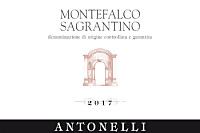
|
|
Montefalco Sagrantino 2017 |
|
| Antonelli San Marco (Umbria, Italy) | |
 Sagrantino Sagrantino | |
| Price: € 24.00 | Score: |
 Intense ruby red and nuances of garnet red, little transparency. Intense ruby red and nuances of garnet red, little transparency. Intense, clean, pleasing, refined and elegant, starts with hints of
blackberry, plum and black cherry followed by aromas of dried violet,
blueberry, tamarind, cocoa, tobacco, face powder, leather, licorice, mace,
pink pepper, vanilla and menthol. Intense, clean, pleasing, refined and elegant, starts with hints of
blackberry, plum and black cherry followed by aromas of dried violet,
blueberry, tamarind, cocoa, tobacco, face powder, leather, licorice, mace,
pink pepper, vanilla and menthol.
 Tannic attack and however balanced by alcohol, full body, intense
flavors, pleasing roundness. Tannic attack and however balanced by alcohol, full body, intense
flavors, pleasing roundness.
 Persistent finish with flavors of blackberry, plum and black cherry. Persistent finish with flavors of blackberry, plum and black cherry. 36 months in cask, 6 months in cement tanks, 12 months in bottle. 36 months in cask, 6 months in cement tanks, 12 months in bottle. |
|
 Game, Roasted meat, Stewed and braised meat, Hard cheese Game, Roasted meat, Stewed and braised meat, Hard cheese |
|
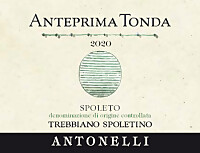
|
|
Spoleto Trebbiano Spoletino Anteprima Tonda 2020 |
|
| Antonelli San Marco (Umbria, Italy) | |
 Trebbiano Spoletino Trebbiano Spoletino | |
| Price: € 17.50 | Score: |
 Deep golden yellow and nuances of golden yellow, very transparent. Deep golden yellow and nuances of golden yellow, very transparent. Intense, clean, pleasing, refined and elegant, starts with hints of
medlar, quince and apricot followed by aromas of broom, hawthorn, citron,
pear, plum, citrus fruit peel, peach, pineapple, hazelnut, rosemary,
oregano, linden, lemon balm and butter. Intense, clean, pleasing, refined and elegant, starts with hints of
medlar, quince and apricot followed by aromas of broom, hawthorn, citron,
pear, plum, citrus fruit peel, peach, pineapple, hazelnut, rosemary,
oregano, linden, lemon balm and butter.
 Crisp attack and however balanced by alcohol, good body, intense
flavors, pleasing roundness. Crisp attack and however balanced by alcohol, good body, intense
flavors, pleasing roundness.
 Very persistent finish with long flavors of medlar, quince and apricot. Very persistent finish with long flavors of medlar, quince and apricot. 9 months in terracotta and ceramic jars, 6 months in bottle. 9 months in terracotta and ceramic jars, 6 months in bottle. |
|
 Stuffed pasta with meat and mushrooms, Roasted white meat, Roasted fish, Mushrooms and legume soups, Cheese Stuffed pasta with meat and mushrooms, Roasted white meat, Roasted fish, Mushrooms and legume soups, Cheese |
|
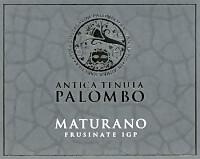
|
|
Maturano |
|
| Antica Tenuta Palombo (Latium, Italy) | |
 Maturano Maturano | |
| Price: € 10.50 | Score: |
 Intense straw yellow and nuances of golden yellow, very transparent. Intense straw yellow and nuances of golden yellow, very transparent. Intense, clean, pleasing and refined, starts with hints of apple, plum
and hawthorn followed by aromas of grapefruit, medlar, pear, peach,
pineapple, rosemary and mineral. Intense, clean, pleasing and refined, starts with hints of apple, plum
and hawthorn followed by aromas of grapefruit, medlar, pear, peach,
pineapple, rosemary and mineral.
 Crisp attack and however balanced by alcohol, good body, intense
flavors, agreeable. Crisp attack and however balanced by alcohol, good body, intense
flavors, agreeable.
 Persistent finish with flavors of apple, plum and grapefruit. Persistent finish with flavors of apple, plum and grapefruit. Aged in steel tanks. Aged in steel tanks. |
|
 Stuffed pasta with meat and mushrooms, Roasted fish, Roasted white meat, Mushroom and legume soups Stuffed pasta with meat and mushrooms, Roasted fish, Roasted white meat, Mushroom and legume soups |
|

|
|
Atina Cabernet Riserva Duca Cantelmo 2017 |
|
| Antica Tenuta Palombo (Latium, Italy) | |
 Cabernet Sauvignon Cabernet Sauvignon | |
| Price: € 32.00 | Score: |
 Deep ruby red and nuances of garnet red, little transparency. Deep ruby red and nuances of garnet red, little transparency. Intense, clean, pleasing, refined and elegant, starts with hints of
black currant, black cherry and peony followed by aromas of violet, plum,
blueberry, blackberry, chocolate, tobacco, carob, bell pepper, leather,
pink pepper, mace, oregano, vanilla and eucalyptus. Intense, clean, pleasing, refined and elegant, starts with hints of
black currant, black cherry and peony followed by aromas of violet, plum,
blueberry, blackberry, chocolate, tobacco, carob, bell pepper, leather,
pink pepper, mace, oregano, vanilla and eucalyptus.
 Properly tannic attack and however balanced by alcohol, full body,
intense flavors, pleasing roundness. Properly tannic attack and however balanced by alcohol, full body,
intense flavors, pleasing roundness.
 Persistent finish with flavors of black currant, black cherry and plum. Persistent finish with flavors of black currant, black cherry and plum. More than 12 months in barrique, 8 months in steel tanks, at least 12
months in bottle. More than 12 months in barrique, 8 months in steel tanks, at least 12
months in bottle.
|
|
 Game, Braised and stewed meat with mushrooms, Roasted meat, Cheese Game, Braised and stewed meat with mushrooms, Roasted meat, Cheese |
|
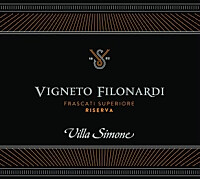
|
|
Frascati Superiore Riserva Vigneto Filonardi 2021 |
|
| Villa Simone (Latium, Italy) | |
 Malvasia del Lazio (56%), Malvasia di Candia (44%) Malvasia del Lazio (56%), Malvasia di Candia (44%) | |
| Price: € 14.00 | Score: |
 Brilliant greenish yellow and nuances of greenish yellow, very
transparent. Brilliant greenish yellow and nuances of greenish yellow, very
transparent.
 Intense, clean, pleasing and refined, starts with hints of pear, apple
and hawthorn followed by aromas of acacia, broom, peach, citrus fruits,
pineapple, almond and mineral. Intense, clean, pleasing and refined, starts with hints of pear, apple
and hawthorn followed by aromas of acacia, broom, peach, citrus fruits,
pineapple, almond and mineral.
 Crisp attack and however balanced by alcohol, good body, intense
flavors, agreeable. Crisp attack and however balanced by alcohol, good body, intense
flavors, agreeable.
 Persistent finish with flavors of pear, apple and peach. Persistent finish with flavors of pear, apple and peach. 6 months in steel tanks, 6 months in bottle. 6 months in steel tanks, 6 months in bottle. |
|
 Pasta and risotto with fish, Fried fish, Sauteed white meat, Stewed fish Pasta and risotto with fish, Fried fish, Sauteed white meat, Stewed fish |
|
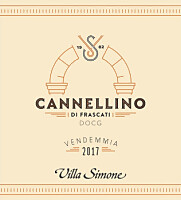
|
|
Cannellino di Frascati 2017 |
|
| Villa Simone (Latium, Italy) | |
 Malvasia del Lazio (90%), Malvasia di Candia (10%) Malvasia del Lazio (90%), Malvasia di Candia (10%) | |
| Price: € 20.00 - 500ml | Score: |
 Brilliant amber yellow and nuances of amber yellow, transparent. Brilliant amber yellow and nuances of amber yellow, transparent. Intense, clean, pleasing and refined, starts with hints of raisin,
peach jam and dried apricot followed by aromas of quince jam, pear jam,
candied fruits, citrus fruit peel, honey, almond, vanilla and nail polish. Intense, clean, pleasing and refined, starts with hints of raisin,
peach jam and dried apricot followed by aromas of quince jam, pear jam,
candied fruits, citrus fruit peel, honey, almond, vanilla and nail polish.
 Sweet and round attack, however balanced by alcohol, good body, intense
flavors, pleasing crispness. Sweet and round attack, however balanced by alcohol, good body, intense
flavors, pleasing crispness.
 Persistent finish with flavors of raisin, peach jam and dried apricot. Persistent finish with flavors of raisin, peach jam and dried apricot. 14 months in cask, 12 months in bottle. 14 months in cask, 12 months in bottle. |
|
 Confectionery, Fruit tarts, Hard cheese Confectionery, Fruit tarts, Hard cheese |
|
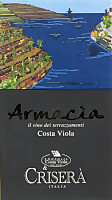
|
|
Costa Viola Armacia 2021 |
|
| Criserà (Calabria, Italy) | |
 Prunesta, Malvasia Nera, Nerello, Gaglioppo Prunesta, Malvasia Nera, Nerello, Gaglioppo | |
| Price: € 9.00 | Score: |
 Deep ruby red and nuances of ruby red, little transparency. Deep ruby red and nuances of ruby red, little transparency. Intense, clean, pleasing and refined, starts with hints of plum, black
cherry and blackberry followed by aromas of violet, rose, cyclamen,
pomegranate, raspberry, blueberry and carob. Intense, clean, pleasing and refined, starts with hints of plum, black
cherry and blackberry followed by aromas of violet, rose, cyclamen,
pomegranate, raspberry, blueberry and carob.
 Properly tannic attack and however balanced by alcohol, good body,
intense flavors, agreeable. Properly tannic attack and however balanced by alcohol, good body,
intense flavors, agreeable.
 Persistent finish with flavors of plum, black cherry and blackberry. Persistent finish with flavors of plum, black cherry and blackberry. Aged in steel tanks. Aged in steel tanks. |
|
 Stuffed pasta with meat, Sauteed meat with mushrooms, Roasted white meat, Cheese Stuffed pasta with meat, Sauteed meat with mushrooms, Roasted white meat, Cheese |
|
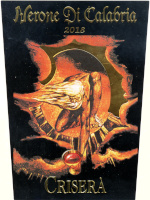
|
|
Nerone di Calabria 2018 |
|
| Criserà (Calabria, Italy) | |
 Nerello Calabrese (70%), Sangiovese (30%) Nerello Calabrese (70%), Sangiovese (30%) | |
| Price: € 20.00 | Score: |
 Intense ruby red and nuances of garnet red, little transparency. Intense ruby red and nuances of garnet red, little transparency. Intense, clean, pleasing and refined, starts with hints of plum,
blackberry and black cherry followed by aromas of dried violet, blueberry,
carob, tobacco, chocolate, oregano and vanilla. Intense, clean, pleasing and refined, starts with hints of plum,
blackberry and black cherry followed by aromas of dried violet, blueberry,
carob, tobacco, chocolate, oregano and vanilla.
 Properly tannic attack and however balance by alcohol, good body,
intense flavors, pleasing roundness. Properly tannic attack and however balance by alcohol, good body,
intense flavors, pleasing roundness.
 Persistent finish with flavors of plum, black cherry and blackberry. Persistent finish with flavors of plum, black cherry and blackberry. Fermented and aged in barrique and cask. Fermented and aged in barrique and cask. |
|
 Stuffed pasta with meat and mushrooms, Roasted meat, Broiled meat and barbecue, Stewed meat with mushrooms, Cheese Stuffed pasta with meat and mushrooms, Roasted meat, Broiled meat and barbecue, Stewed meat with mushrooms, Cheese |
|
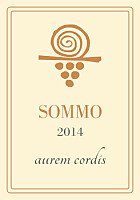
|
|
Sommo 2014 |
|
| Terre di Serrapetrona - Tenuta Stefano Graidi (Marches, Italy) | |
 Vernaccia Nera Vernaccia Nera | |
| Price: € 20.00 - 500ml | Score: |
 Deep ruby red and nuances of garnet red, little transparency. Deep ruby red and nuances of garnet red, little transparency. Intense, clean, pleasing, refined and elegant, starts with hints of
black cherry, plum and blueberry followed by aromas of dried violet,
strawberry, blackberry, tamarind, tobacco, cocoa, cinnamon, leather,
vanilla and menthol. Intense, clean, pleasing, refined and elegant, starts with hints of
black cherry, plum and blueberry followed by aromas of dried violet,
strawberry, blackberry, tamarind, tobacco, cocoa, cinnamon, leather,
vanilla and menthol.
 Sweet and properly tannic attack, however balanced by alcohol, good
body, intense flavors, pleasing roundness. Sweet and properly tannic attack, however balanced by alcohol, good
body, intense flavors, pleasing roundness.
 Persistent finish with flavors of cherry, plum and blueberry. Persistent finish with flavors of cherry, plum and blueberry. 24 months in steel tanks, 36 months in cask, 12 months in bottle. 24 months in steel tanks, 36 months in cask, 12 months in bottle. |
|
 Fruit tarts, Confectionery, Hard cheese Fruit tarts, Confectionery, Hard cheese |
|
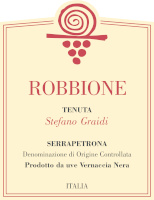
|
|
Serrapetrona Robbione 2015 |
|
| Terre di Serrapetrona - Tenuta Stefano Graidi (Marches, Italy) | |
 Vernaccia Nera Vernaccia Nera | |
| Price: € 28.00 | Score: |
 Deep ruby red and nuances of garnet red, little transparency. Deep ruby red and nuances of garnet red, little transparency. Intense, clean, pleasing, refined and elegant, starts with hints of
black cherry, plum and blackberry followed by aromas of dried violet,
strawberry, raspberry, blueberry, cocoa, tobacco, leather, black pepper,
licorice, mace, rosemary, graphite, vanilla and menthol. Intense, clean, pleasing, refined and elegant, starts with hints of
black cherry, plum and blackberry followed by aromas of dried violet,
strawberry, raspberry, blueberry, cocoa, tobacco, leather, black pepper,
licorice, mace, rosemary, graphite, vanilla and menthol.
 Properly tannic attack and however balanced by alcohol, good body,
intense flavors, pleasing roundness. Properly tannic attack and however balanced by alcohol, good body,
intense flavors, pleasing roundness.
 Very persistent finish with long flavors of black cherry, plum and
blackberry. Very persistent finish with long flavors of black cherry, plum and
blackberry.
 24 months in steel tanks, 36 months in cask, 12 months in bottle. 24 months in steel tanks, 36 months in cask, 12 months in bottle. |
|
 Broiled meat and barbecue, Stewed meat with mushrooms, Roasted meat, Cheese Broiled meat and barbecue, Stewed meat with mushrooms, Roasted meat, Cheese |
|
News |
|
In this section are published news and information about events concerning the world of wine and food. Whoever is interested in publishing this kind of information can send us a mail to our address.
|
AquavitaeReview of Grappa, Distillates and Brandy |
|
|
||||||||||||
Wine Guide ParadeJune 2023
|
| |||||||
Privacy Policy | |||||||


| Copyright © 2002-2024 Antonello Biancalana, DiWineTaste - All rights reserved |
| All rights reserved under international copyright conventions. No part of this publication and of this WEB site may be
reproduced or utilized in any form or by any means, electronic or mechanical, without permission in writing from DiWineTaste. |